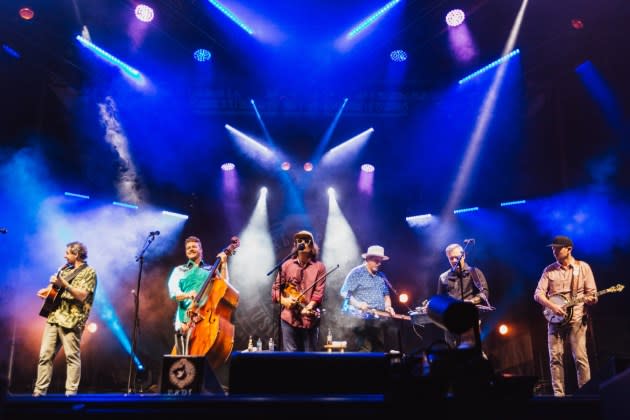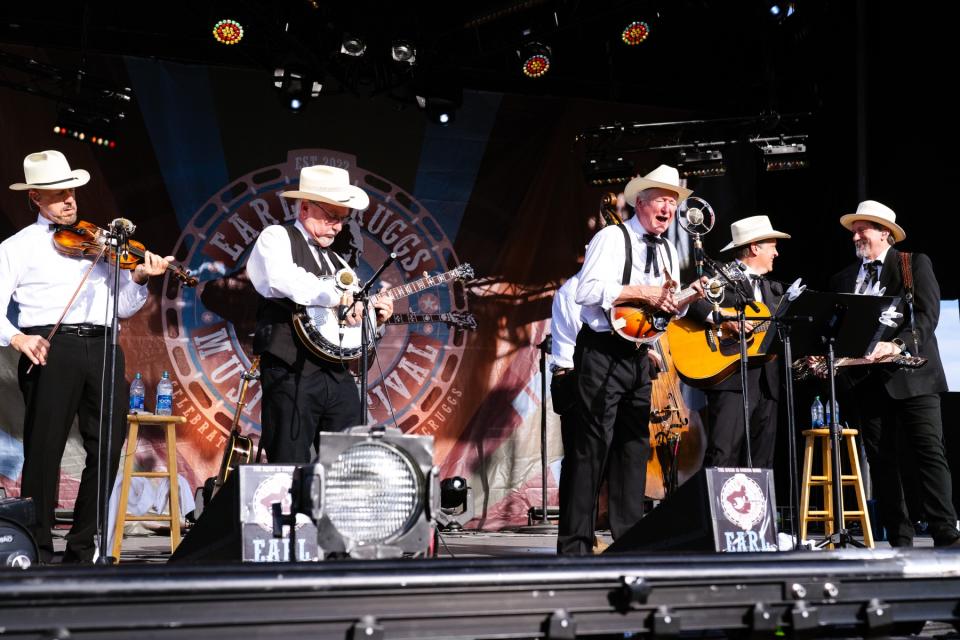Earl Scruggs Shaped Bluegrass — and Jam-Grass Too. A New Festival Aims to Revive His Legacy

When he was three years old, Jerry Douglas heard the groundbreaking banjo licks of Earl Scruggs on the turntable each morning during breakfast at his childhood home in northeastern Ohio.
“And we’d hear the Flatt & Scruggs [Grand Ole Opry] radio show on WSM if there was clear weather between Ohio and Nashville,” Douglas, a staple of today’s bluegrass, tells Rolling Stone. “Flatt & Scruggs was a big deal in our house. But, Earl’s banjo playing was the first thing I ever heard that I wanted to do — nothing was ever the same for me after that.”
More from Rolling Stone
Bluegrass Lost Two Pioneers in Mere Days: Why Bobby Osborne and Jesse McReynolds Matter
How Nefesh Mountain Are Fighting Anti-Semitism With Traditional Bluegrass
John Hiatt, Jerry Douglas Band Preview Collaborative Album With 'All the Lilacs in Ohio'
Sitting on a patio at the Tryon International Equestrian Center in rural Western North Carolina, Douglas gazes out over the large horse arenas and stables dotting the massive, bucolic property. At the recent Earl Scruggs Music Festival held onsite at the TIEC, Douglas was once again master of ceremonies.
As a tribute to the late Scruggs, who died in 2012, and his enduring legacy, the gathering showcased marquee names in bluegrass, jam-grass and Americana, including Del McCoury Band, Greensky Bluegrass, Emmylou Harris, the Infamous Stringdusters, Earls of Leicester, Della Mae, Michael Cleveland & Flamekeeper, and Sister Sadie.
“We’re here to honor the finest banjo-picker in the world,” McCoury says. “He was an innovator and he was a genius when it came to playing banjo.”
The festival is put on by a handful of beneficiaries, including the Earl Scruggs Center located just down the road in Scruggs’ native Shelby, WNCW 88.7 FM, and Isothermal Community College.
“There was no bluegrass until there was Earl Scruggs,” Douglas says. “Bill Monroe was looking for it, but it wasn’t until he auditioned Earl when he finally found it — that was the hallelujah moment for Monroe.”
Now 67, Douglas is regarded as an American musical institution and pillar of the bluegrass, country, and Americana scenes. Known as one of the finest dobro players on the planet, Douglas has 14 Grammy wins under his belt alongside 32 nominations. And yet, for Douglas, his musical journey all began with Scruggs — a tale as old as time for countless other musicians over the decades.
“Earl didn’t see the banjo as any kind of limitation to what kind of genre he would hop into — it was a conduit for whatever thoughts he had,” Douglas says. “And he was one of the first people that could do that and jump genres. He believed there was always something you could learn and take away with you.”
Those sentiments from Douglas lie at the heart of what made Earl Scruggs such a pivotal figure in the history of American music.
“There’s no denying the power in the right hand of Earl Scruggs,” says Jeremy Garrett, fiddler for the Stringdusters, backstage before his set. “You listen to players today, and they’re still trying to get that same power Earl had in the beginning [of bluegrass]. He played music with such intention and sheer force.”
Born in 1924 in Cleveland County, North Carolina, Scruggs was a product of his hardworking, blue-collar roots, a setting where porch pickin’-n-grinnin’ was a cherished activity in one’s free time. It was also ground zero for learning all you could about different playing styles, songs, and note combinations.
“You’ve got to know where you came from and the way you started,” McCoury says. “Growing up, Earl, Lester Flatt and Bill Monroe were all big heroes of mine. I learned everything from them, and they learned from other people before them. They were sponges.”
Scruggs became world-renowned for his unique three-finger picking style — known as “Scruggs style” — on the banjo, a technique far-removed from previous traditional and claw-hammer styles that dominated the musical landscape.
“Whereas claw-hammer is a down-stroke style, Scruggs style is very hard-driving,” says banjo great Tony Trischka. “Though the three-finger style had been going on since the 1860s, Earl formalized it, adding in all these licks, elements of jazz and various other types of music he liked.”
For most, if not all, bluegrass lovers, musicians, and historians, the moment Scruggs auditioned for Monroe in 1945 and got the gig to join Monroe’s Blue Grass Boys is the “Big Bang of Bluegrass Music.” The group, which also included guitarist Lester Flatt, made its debut on the Grand Ole Opry in December 1945 to rave reviews, the fevered audience roaring for encore after encore.
“Once [Earl] joined the Blue Grass Boys, everything changed. It was gas thrown on the fire of what Monroe wanted to ultimately do — Earl was the missing piece,” Trischka says. “I mean, people had heard banjo before, but nothing like that.”
By 1948, Earl and Lester left Monroe to form their own highly successful duo, Flatt & Scruggs. Beyond their own innovative musical styles and influences, the pair were responsible for numerous hit records, most notably the 1962 radio smash “The Ballad of Jed Clampett,” the TV theme song for The Beverly Hillbillies.
Flatt & Scruggs would disband in 1969 and Scruggs formed a group with his sons, the Earl Scruggs Revue, a revolutionary string act that opened up avenues of sonic possibility and collaboration, including shows alongside the likes of the Byrds, James Taylor, and Steppenwolf. In 1972, Scruggs appeared on the landmark Nitty Gritty Dirt Band album Will the Circle Be Unbroken.
“Earl was a very open-minded guy. The purists who listen to Flatt & Scruggs don’t necessarily appreciate how progressive Earl was over the years — all the different music configurations he was involved in, all the genres he dove into,” Garrett says. “And I think a lot of people forget that even the innovators were, well, innovators — they were rebels, and we’re just continuing that same kind of tradition.”

Until his passing in 2012 at age 88, Scruggs continued his lifelong melodic quest to seek out new players and fresh ways of wandering the fretboard of his trusty five-string instrument. Play music for music’s sake. Have fun. Erase boundaries, but never forget the fundamentals and skill set of the “high, lonesome sound.”
All are which are hard-fought and closely-held characteristics of today’s jam-grass music, with Greensky Bluegrass and the Infamous Stringdusters at the forefront.
“We used to feel a little bit out of place at bluegrass functions, but I think what we do is just as genuine and that translates,” says Greensky frontman Paul Hoffman. “When it’s heavy, weird or psychedelic, I don’t feel like we’re ‘doing it wrong.’ I guess I have faith that people understand we are just celebrating all of our influences and inspiration.”
For Douglas, it’s also a full-circle kind of moment whenever he gets onstage with his ensemble, the Earls of Leicester. Since its 2013 inception, the Earls have crisscrossed the nation with a staggering tribute act to the sights and sounds of Flatt & Scruggs.
“I formed the Earls of Leicester to make a point, to bring back and reinsert that original style of bluegrass back into the [modern] lexicon,” Douglas says. “It felt like Flatt & Scruggs had been dropped somewhere along the way — it was time to bring it back, to show the mystique of the band and its stage presence.”
Onstage at the festival, the Earls, adorned in period-accurate clothing, rolled through key selections from the sacred catalog of songs, each number just as powerful and striking in the 21st century as when the tunes were brand new exactly 75 years ago.
“Earl was a very kind, soft-spoken man who didn’t realize what he had done, which was change music forever,” Douglas says. “And he didn’t brag, he just did it. All he wanted to do was play — all he expected was for you to keep up.”
Best of Rolling Stone
